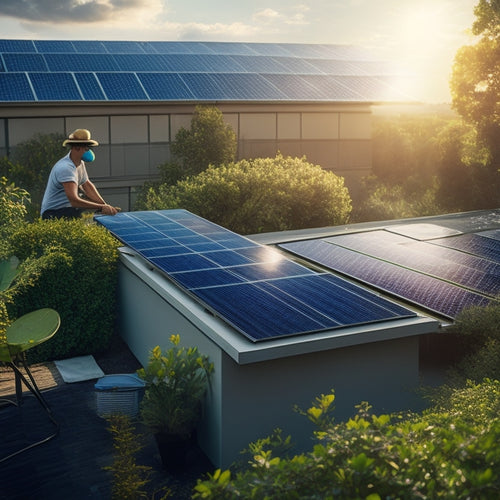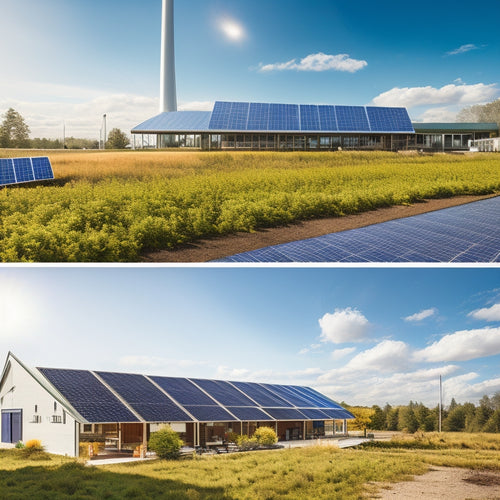
What Are the Top Countries With the Lowest Solar Electricity Price
Share
You're likely wondering which countries have achieved the lowest solar electricity prices, driven by a combination of technological advancements, economies of scale, and supportive policies. Chile, Mexico, Australia, India, and the United Arab Emirates have emerged as leaders, with average solar electricity prices ranging from 2.91 to 3.54 cents per kilowatt-hour. These countries' adoption of competitive auction bidding, financing options, and government incentives have accelerated cost reductions. As you investigate the factors influencing these prices, you'll uncover how regional policies, irradiance, and installation costs shape the global solar electricity environment, and what it might mean for the future of renewable energy.
Key Takeaways
- Saudi Arabia has the lowest solar tariff globally, at 1.79 cents per kilowatt-hour (kWh), due to competitive auction bidding.
- Chile offers an average solar electricity price of 2.91 cents/kWh, making it one of the countries with the cheapest solar electricity.
- Mexico's average solar electricity price is 3.35 cents/kWh, driven by attractive renewable incentives and competitive bidding.
- Australia's average solar electricity price is 3.44 cents/kWh, supported by government incentives and a favorable policy environment.
- India's average solar electricity price is 3.48 cents/kWh, with a goal to achieve grid parity and a more decentralized renewable energy framework.
Global Solar Electricity Price Trends
Across the globe, solar electricity prices have been plummeting over the past decade, driven by advancements in technology, economies of scale, and favorable policies.
You're witnessing an extraordinary shift in the energy environment, where solar electricity is becoming increasingly competitive with fossil fuels.
The solar policy environment has evolved considerably, with governments worldwide implementing supportive policies to drive adoption. As a result, market conditions have changed, and investment trends have shifted towards renewable energy.
You're seeing a surge in consumer adoption, driven by the desire for energy independence and a reduced environmental impact.
Technological advancements have improved grid integration, allowing solar energy to seamlessly integrate with traditional power sources.
Government incentives have played a vital role in driving down costs, making solar electricity more accessible to the masses.
As you investigate the top countries with the lowest solar electricity prices, you'll notice a common thread - a combination of progressive solar policies, technological innovations, and investment in renewable energy.
The Cost of Solar Energy Installation
You'll want to evaluate the system costs, which encompass the expenses associated with purchasing and installing solar panels, inverters, and other necessary equipment.
Upfront expenses, including labor, permitting, and installation fees, can greatly impact the overall cost of solar energy installation.
System Costs
System costs, comprising the upfront expenditure for installing solar energy infrastructure, have plummeted dramatically over the years, making solar electricity more competitive with fossil fuels.
You can now install a solar energy system at a lower cost, thanks to advancements in technology and manufacturing. The average system cost has fallen by over 70% in the last decade, driven by improvements in system efficiency.
This decline in system costs has been further accelerated by installation incentives, such as tax credits and feed-in tariffs, offered by governments to encourage the adoption of renewable energy.
As a result, the cost of generating solar electricity has become increasingly competitive with traditional fossil fuels, making it a viable option for power generation.
With system costs continuing to decline, you can expect solar electricity to become even more competitive in the future.
This trend is expected to drive growth in the solar energy sector, leading to increased adoption and reduced greenhouse gas emissions.
Upfront Expenses
As solar electricity becomes increasingly competitive with fossil fuels, understanding the upfront expenses involved in installing a solar energy system is essential. You'll need to evaluate the initial investment required to get your solar energy system up and running.
| Component | Cost Range |
|---|---|
| Solar Panels | $2,500 - $3,500 |
| Inverter and Mounting | $1,500 - $2,500 |
| Installation Labor | $2,000 - $3,000 |
These costs can add up quickly, but there are ways to mitigate the financial burden. You can investigate financing options, such as loans or power purchase agreements, to spread the cost over time. Additionally, government incentives like tax credits or rebates can help offset the upfront expenses. By understanding these costs and investigating available incentives, you can make a more informed decision about investing in solar energy.
Countries With Lowest Solar Tariffs
You're about to investigate the countries that have achieved the lowest solar tariffs, which are led by solar power champions that have driven down costs through auction bidding wars.
These competitive bidding processes have resulted in some of the cheapest electricity deals globally.
Now, let's examine the countries that have secured the lowest solar tariffs, which are essential in making solar energy a viable alternative to fossil fuels.
Solar Power Champions
Across the globe, solar power has become increasingly competitive with fossil fuels, driven by plummeting tariffs that have made it more economical for countries to shift to clean energy.
You're likely wondering which countries have achieved the lowest solar electricity prices.
Saudi Arabia leads the pack with a record-low tariff of 1.79 cents per kilowatt-hour (kWh). This is largely due to its massive solar projects and favorable climate.
The United Arab Emirates follows closely with a tariff of 2.04 cents/kWh, thanks to its aggressive renewable incentives and solar innovation.
Chile, Peru, and Mexico also make the top five, with tariffs ranging from 2.15 to 2.51 cents/kWh. These countries have successfully utilized their high irradiance levels and implemented policies to drive down costs.
As you investigate the global solar environment, you'll notice a common thread: countries that have made remarkable progress in solar innovation and offered attractive renewable incentives have been able to achieve the lowest solar electricity prices.
Auction Bidding Wars
In the pursuit of affordable clean energy, governments have intensified auction bidding wars, driving down solar tariffs to unparalleled lows. You're witnessing a cutthroat competition, where developers employ aggressive bidding strategies to outmaneuver rivals.
Auction interplay has become increasingly complex, with companies conducting thorough competitor analysis to stay ahead in the game. The resulting price wars have led to market saturation, forcing governments to reassess their policy impacts on the industry.
As you traverse this environment, you'll notice distinct regional differences in investment trends. Some countries have created favorable policy environments, attracting heavy investments in solar infrastructure.
Others, however, struggle to keep up due to regulatory obstacles or lack of incentives. Amidst this chaos, you must stay vigilant, analyzing the complexities of each market to capitalize on emerging opportunities.
The global solar market is in a state of flux, but one thing is clear: the countries that adapt and innovate will reap the benefits of this bidding war, securing the lowest solar tariffs and cementing their position as leaders in the renewable energy space.
Cheapest Electricity Deals
The current solar tariff situation is dominated by a handful of countries that have managed to secure exceptionally low prices for solar electricity. You're likely wondering which countries have achieved the cheapest electricity deals.
As you investigate the global renewable energy arena, you'll find that countries with low solar tariffs have one thing in common: they've implemented policies to drive down costs and attract investment.
The top countries with the lowest solar tariffs have achieved bids as low as 1.3-1.7 cents per kilowatt-hour (kWh). These countries have utilized auction-based bidding systems, which have driven down prices through intense competition.
Additionally, they've implemented supportive policies, such as electricity subsidies, to encourage the adoption of renewable energy. By doing so, they've created an attractive environment for investors, leading to a surge in solar project development.
As a result, you can expect to see even lower solar tariffs in the future, making renewable energy an increasingly viable option for powering your operations.
Solar Electricity Prices by Region
Solar electricity prices vary greatly by region, largely driven by differences in irradiance, installation costs, and policy structures. You'll notice that prices fluctuate greatly depending on where you are in the world. Regional policies, such as solar incentives and tax credits, also play a significant role in shaping the cost of solar electricity.
| Region | Average Solar Electricity Price (€ /kWh) |
|---|---|
| North America | 3.5-5.5 |
| Latin America | 4.5-7.5 |
| Europe | 5.5-8.5 |
| Asia | 2.5-4.5 |
You can see that North America and Asia tend to have lower prices, while Europe and Latin America have higher prices. This is due to a combination of factors, including the cost of installation, local labor costs, and the amount of sunlight each region receives. Additionally, regional policies, such as feed-in tariffs and renewable portfolio standards, can also impact the cost of solar electricity. Understanding these regional differences is essential for investors, policymakers, and consumers looking to utilize the power of solar energy.
Top 5 Countries With Cheapest Solar
Across the globe, you'll find that certain countries have made significant advancements in reducing the cost of solar electricity, making it more accessible and affordable for consumers.
These countries have implemented effective solar incentives and renewable policies, driving down the cost of solar electricity.
According to recent data, the top 5 countries with the cheapest solar electricity prices are Chile, Mexico, Australia, India, and the United Arab Emirates.
Chile leads the pack with an average solar electricity price of 2.91 cents per kilowatt-hour (kWh), followed closely by Mexico at 3.35 cents/kWh.
Australia ranks third at 3.44 cents/kWh, with India and the UAE following at 3.48 cents/kWh and 3.54 cents/kWh, respectively.
These countries have achieved such low prices through a combination of favorable climates, large-scale solar installations, and supportive government policies.
Falling Solar Panel Costs Worldwide
In recent years, you've witnessed a dramatic decline in solar panel costs worldwide, driven primarily by advancements in manufacturing technology and economies of scale. This downward trend has been propelled by solar panel innovations, which have improved efficiency and reduced production costs. As a result, the global average cost of solar panels has fallen by over 70% in the past decade.
Global manufacturing trends have also played a significant role in reducing solar panel costs. Large-scale production facilities, particularly in Asia, have enabled manufacturers to take advantage of economies of scale, leading to lower production costs per unit.
Additionally, the increasing adoption of automation and robotics in manufacturing has further reduced labor costs.
The cumulative effect of these factors has been a significant decrease in the cost of solar electricity. In 2020, the global average levelized cost of solar electricity (LCOE) was approximately $30 per megawatt-hour (MWh), down from over $100 per MWh in 2010.
This trend is expected to continue, making solar electricity an increasingly competitive option with fossil fuels.
Future of Solar Electricity Pricing
As the cost of solar electricity continues to fall, you're likely wondering what the future holds for this renewable energy source. The trend is expected to continue, driven by policy incentives and technological advancements.
Here's what you can expect:
-
Increased adoption: As solar electricity becomes more competitive with fossil fuels, you'll see more countries and companies investing in solar power infrastructure.
-
Grid parity: Solar electricity will reach grid parity in more regions, making it a viable alternative to traditional energy sources.
-
Energy storage advancements: Improved energy storage technologies will enable better management of intermittent solar power, making it a more reliable option.
- Global solar electricity prices dropping below $20/MWh: This milestone will be reached in several countries, making solar electricity an increasingly attractive option for power generation.
These developments will solidify solar electricity's position as a key player in the global energy mix, driving a cleaner, more sustainable future.
As the cost of solar electricity continues to fall, you can expect to see significant growth in the industry, leading to a more decentralized, renewable energy framework.
Frequently Asked Questions
Can Individuals Install Solar Panels on Rented Properties?
You can investigate solar panel installation on rented properties, but it's essential to obtain your landlord's consent and guarantee the lease allows modifications; additionally, you'll need to weigh the costs and benefits, considering the rental period and potential relocation.
Do Governments Offer Incentives for Residential Solar Installations?
You're "on the same page" as many homeowners, wondering if governments offer incentives for residential solar installations. Yes, many governments provide attractive incentives, such as tax credits, rebates, and net metering laws, to encourage you to utilize solar power.
How Does Energy Storage Impact Solar Electricity Pricing?
You'll find that energy storage considerably impacts solar electricity pricing, as advancements in battery technology improve energy efficiency, allowing you to optimize your solar output and reduce grid dependence, ultimately driving down costs.
Are Solar Tariffs Lower for Industrial or Commercial Use?
You'll find that industrial solar tariffs are generally lower than commercial solar tariffs, averaging around 4-6 cents/kWh versus 6-8 cents/kWh, respectively, due to economies of scale and higher power demand in industrial settings.
Can Solar Electricity Be Sold Back to the Grid?
As you capture the sun's fiery energy, you're likely wondering: can you sell excess solar electricity back to the grid? Yes, through solar buyback programs, you can feed the grid and offset your energy bills, leveraging grid integration to maximize your renewable energy investment.
Conclusion
As you gaze out at a future powered by solar electricity, the scenery shifts like a desert sunset - bright, expansive, and full of promise. With costs plummeting worldwide, the top countries with the lowest solar electricity prices are rewriting the rules of energy production. As the industry continues to evolve, one thing is clear: the future of solar electricity pricing is a horizon of endless possibility, where the warmth of innovation illuminates the path to a cleaner, greener tomorrow.
Related Posts
-

Evaluating Solar Power Options for Businesses
Evaluating solar power options for your business can greatly reduce energy costs and enhance sustainability. Start by...
-

Green Ways to Maintain Solar Panels
To maintain your solar panels sustainably, start with regular inspections to catch potential issues early, enhancing ...
-

Off-Grid Solar Solutions for Eco-Conscious Businesses
Off-grid solar solutions offer you a path to both sustainability and substantial cost savings. By adopting these syst...


